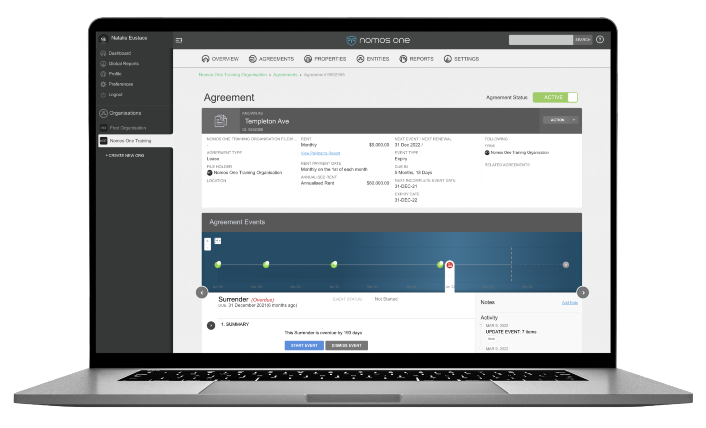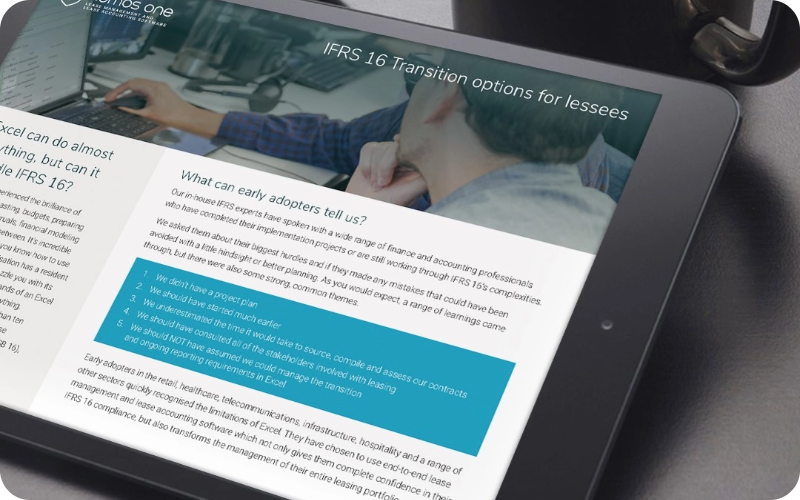We have all probably inherited a job that has felt immediately over our heads. Someone has left, and their workings that remain behind don’t seem to follow any logical setup; there are magic hardcoded numbers everywhere, and nothing seems to tie together. It appears that when the spreadsheet creator left, so did the knowledge of how to understand and continue using it.
Nomos One’s lease accounting software removes the risk of complex calculations getting siloed between one or two people in the business. The platform gives an intuitive, visual understanding of the different events occurring over the life of a lease agreement and how these affect financial reporting. Our calculations and reports are easily accessible and transferrable between finance team members, property team, and beyond.
In addition – our fantastic support team is always on hand to offer technical solutions, additional product training and other tips and tricks to help you out when things need to get done.
Spreadsheet calculations are tough to keep track of and align come year-end
The end of the financial year can be stressful, and there are a lot of different elements that need to come together in a short amount of time. Leasing involves coordinating lots of information, including; establishing contract changes, considering accounting judgements, and updating the calculations themselves. This usually requires collaboration from other teams within your organisation. The end of financial year can be hectic enough without having the added stress of chasing up other teams for vital information.
With Nomos One, the property management and finance teams can work more harmoniously throughout the year. Nomos One creates a place for property managers to document and record any changes to agreements in real-time – which are then automatically factored into any recalculations required for financial reporting. This takes a lot of the nitty-gritty accounting off the table – opening up space for more important things.
Spreadsheet calculations are inflexible and often set up in less-than-optimal ways
With the past couple of years already having their challenges, introducing a new accounting standard was further heaped onto an already substantial workload. IFRS 16 requires specifically tailored spreadsheets which would have been complicated to create irrespective of the other stresses and pressures over this period. A steep learning curve meant that our understanding, comprehension and application of IFRS 16 was developed massively between the initial spreadsheet creation and when this was reviewed for half or full-year purposes. Due to the time involved to overhaul such large and complex initial calculations, these calculations get carried forward with limitations previously not adequately understood.
Unaddressed spreadsheet limitations translate into issues such as the greater risk of misstatement, greater confusion in understanding the spreadsheets, greater time spent reviewing them, difficulty making lease adjustments, and staff continuity concerns.
Through coming on board with Nomos One, the calculation side of things are taken care of, leaving more time to focus on the more critical things – data inputs, key judgements, review and lease portfolio management (yay!).

All lease accountants know that IFRS 16 calculation can be quite complex, making it challenging to grasp all the details and numbers on your balance sheet during the reporting period. This complexity is expected due to the inclusion of many distinct elements in the calculation of each lease agreement, even before accounting for any modifications to this data.
The Daily Calculation Report (DCR) can help you get to grips with exactly how your lease liability and other balance sheet accounts are calculated as of the balance date. In this article, we will cover the following in some detail:
- What is the DCR?
- What is the DCR’s underlying calculation methodology?
- How to review the inputs that make up the lease liability
What is the DCR?
The Daily Calculation Report (DCR) is a detailed report that establishes how each balance sheet and profit and loss account is calculated every day of the lease’s expected term. The Daily Calculation tab of the report uses formulas and cell referencing to show how each account is calculated from the source information.
The DCR can be downloaded as a spreadsheet file for each agreement. This file has several tabs:
- The Journals tab is the daily transactions recognised from the transition date (simplified transition), commencement or other lease start date until its anticipated expiry date.
- The Payments tab shows the different future expected cash flows or payment series that have been recognised over the life of the lease across separate columns.
- The Agreement tab shows the different discount rates and any make-good provisions that have been applied over the life of the lease.
The Daily Calculation tab shows the movements of the balance sheet and profit and loss accounts over every day of the life of the lease from the source information tabs (above).
What is the Daily Calculation Report’s underlying calculation methodology?
To explain the calculation methodology, we will focus on the lease liability as it directly feeds into the right-of-use asset (ROUA) through the transition or commencement journals and subsequent reassessment journals.
The current lease accounting standard, IFRS 16, requires that the lease liability is measured at the present value of the future lease payments expected under the lease. This means that the lease liability is always looking forward at what the lease payments are expected to be in the future – we term these future lease payments “the future payment series”.
As the lease liability model is always forward-looking, the future payment series is based on assumptions about what the rent might be at different points in the future (e.g. following CPI rent reviews, Market rent reviews etc.).
As the future becomes the present, prior assumptions need to be updated with the latest information (e.g. changes in rent amounts or lease terms). This causes a reassessment journal to adjust the lease liability to align with the updated future payment series.
The DCR calculates the lease liability at a point in time by using the XNPV formula to discount all anticipated future lease payments on a daily compounding basis. To make this calculation, the Daily Calculation tab references cells from the payment and agreement input tabs. As the payment series changes over the life of an agreement, new columns are added through the payments tab. The calculation then switches over to using the updated payment series column from the adjustment's effective date.
As there can be many other projected payments on a particular date, each showing through a different payment series column, the current payment series used in calculating the lease liability is identified by column B of the payments tab. This column signifies the payment series column used in the lease liability calculation at that point in time. In the above example, the current payment series calculates the lease liability on 01/07/2019 through column L.
The “IFRS Cash” column is the actual payment series recognised on each day of the agreement. This will be the actual payments made for the rent review events that have been completed, combined with the current projection of the payment series into the future. This payment series will also be recognised through the journal report.

How to review the inputs that make up the lease liability
From understanding our calculation methodology, you will hopefully start to appreciate how vital the payment series is to understand the lease liability.
Questions that frequently arise from our client’s audits or reviews often focus on how the lease liability is calculated at year-end or how they have been remeasured during the year. The DCR is essential for reviewing the details of these queries and can be easily downloaded from the system and provided to auditors.
Addressing these questions again refers to reviewing the underlying payment series through the Payments tab. In the below example – the lease term has been reduced from February 2041 (column M) to February 2021 (column N) from the effective date of July 2020. This is a reassessment that will show through this agreement from July 2020 that will reflect the difference between the present value of column M and the present value of column N. Column C also shows the end date of the lease has changed from row 8645 (February 2041) to February 2021 (row 1340). This can then be checked back to the present contract and accounting judgements.
To review the lease liability as of December 2020 (e.g. end of financial year) – the payment series through column N could be checked to confirm that this reflected the present contract and accounting judgements.
If you would like to understand more about the Daily Calculation Report or our calculation methodology, review your balance sheet and profit and loss accounts using Nomos One, or prepare for year-end, book a demo with one of our IFRS 16 experts.

























